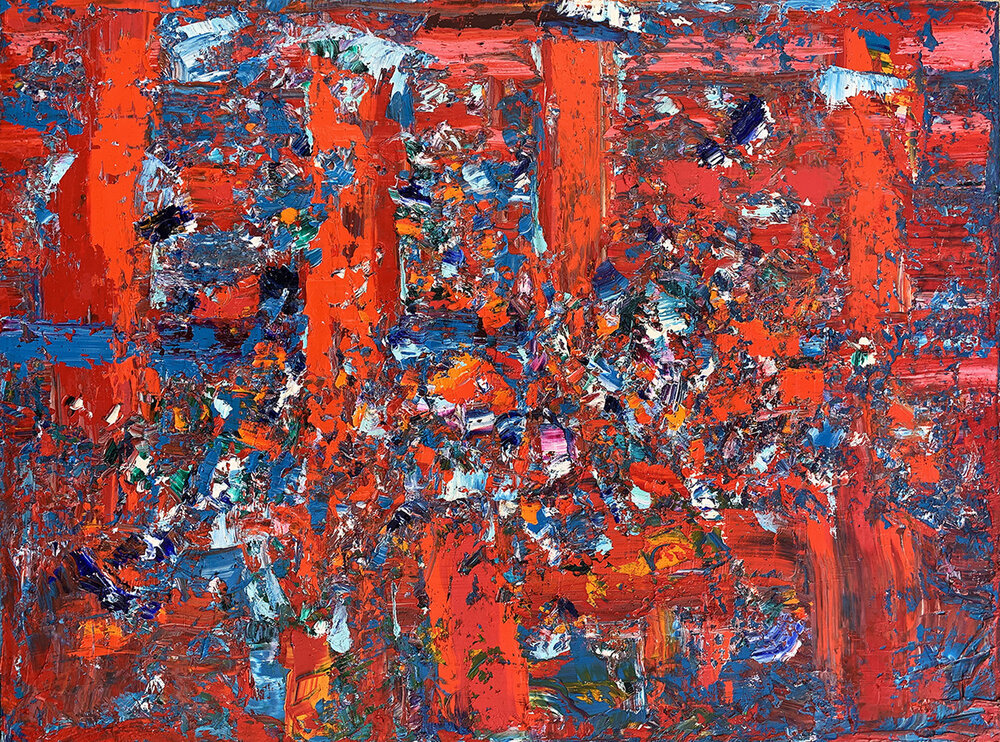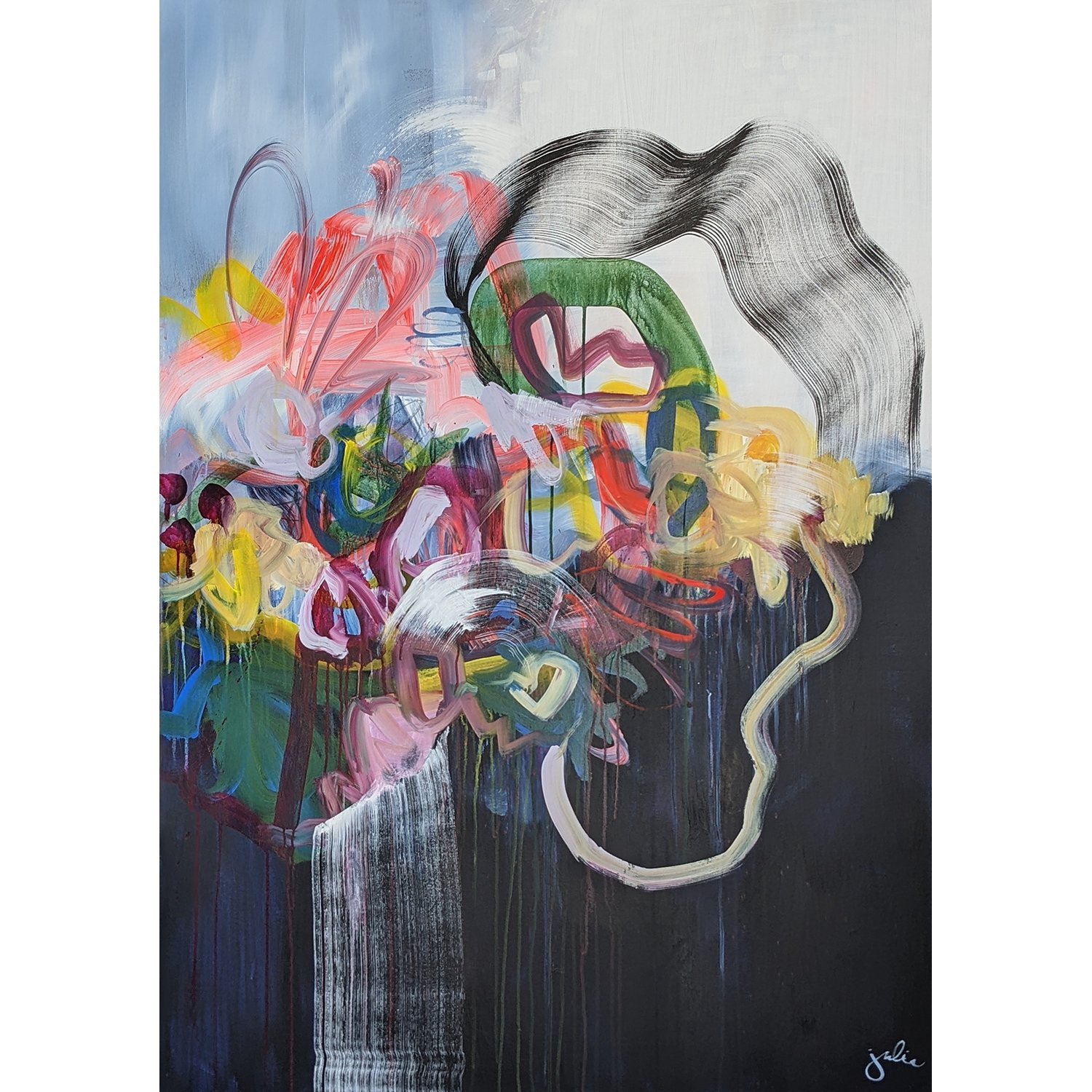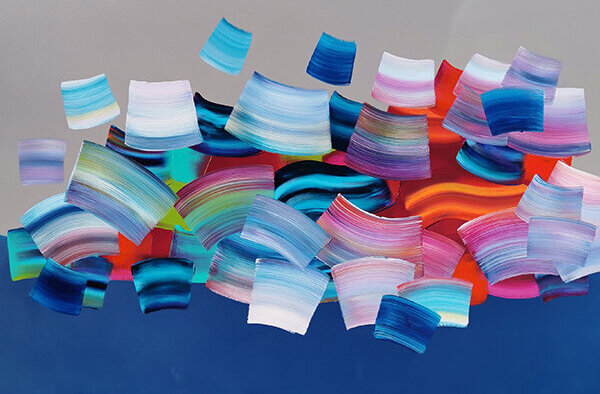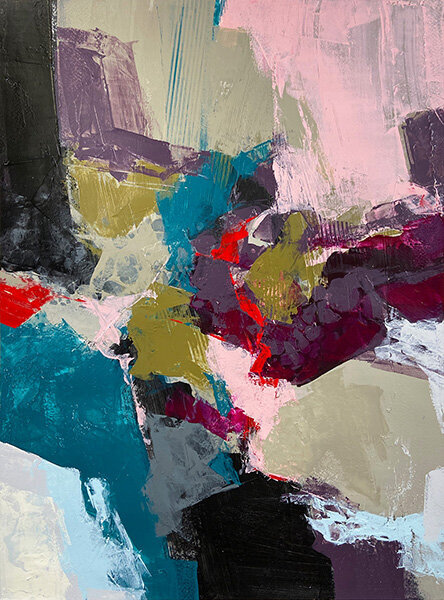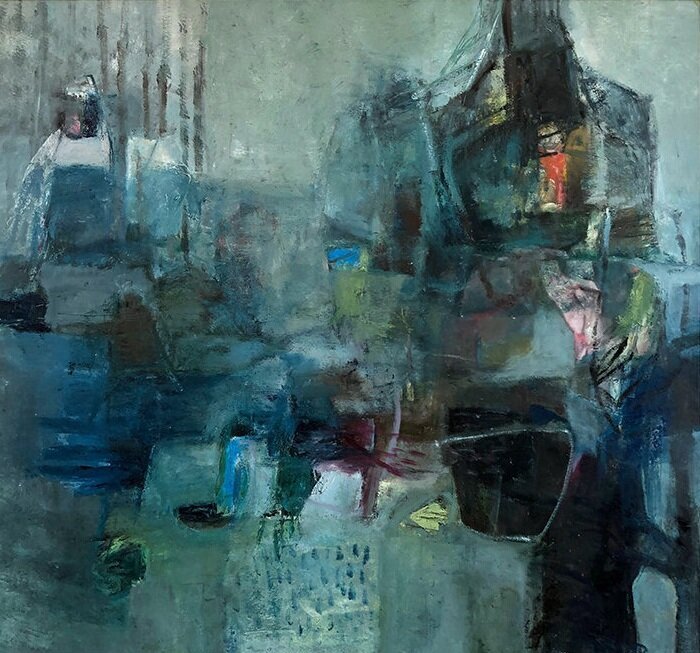Spotlight On: Abstract Artists
Abstract art is defined as: art that does not attempt to represent an accurate depiction of a visual reality but instead use shapes, colours, forms and gestural marks to achieve its effect.
Abstract art, also called nonobjective art or nonrepresentational art, painting, sculpture, or graphic art in which the portrayal of things from the visible world plays no part. All art consists largely of elements that can be called abstract—elements of form, colour, line, tone, and texture.
Here we’ve put together a Spotlight Collection of the abstract artists we represent here at Canvas. We asked the artists to contribute some thoughts about their work if they wished, reflecting on how they relate to and/or define abstraction individually. We’re so impressed with their words and are excited to share them with you.
We hope you enjoy this feature & the beautiful works that make up the collection.
Tom Brooks
"I love dichotomies."
Dichotomies in my work:
Kinetic Colour mixing / structured patterns.
Warm / cool colours.
Complimentary colours.
Contrasts of expansion- small / large.
Improv / planned.
Movement- fast / slow.
Layering- creating / destroying.
Isolating fragments / forming totality.
Painting by addition / sculpting by removal.
Hiding / exposing.
Isolating to create a series of small paintings.
Removing intensifies the remaining.
Jean-Michel Basquiat said, "Erasing makes you look harder."
explore Tom’s work
Sharon Barr
It’s so easy for painting to fall into the (rather unfulfilling) search for perfection. I like to think of perfection and all its variations – timeless beauty, universal archetypes, formulaic precision – as not enemies, or even friends, but riddles, the answers to which matter less than the pursuit of them. Instead, painting for me is about how the abstract can hold all things outside of perfection’s limits and still be beautiful; mess, distraction, deviation, and spontaneity are all mediums. It’s about honouring perfection through its opposites, with equal parts respect and rebellion, awe and agency, in the only way I know how.
Lori Mirabelli
Rachel Albano
My current paintings are a visual representation of a certain feeling. I have paintings that are light and airy, quiet, soft billows of white and greys as if a whisper from a friend says, “We’re in this together.” Other paintings are colourfully bold and beautiful, striking statement pieces that inspire and uplift, and speak to you as you head out the door, “You’re going to rock this day.”
I love that abstract art, through colour and shape, has the ability to change the atmosphere of the room.
explore Rachel’s work
Chris Ahlers
I believe that abstraction in art is a continuum, and all artwork falls somewhere on that scale, and includes elements that are more or less abstract or representational. I suppose my work tends toward the 'more abstract', but I enjoy the tension, energy and variety that including or inserting more representational elements brings. The human brain is adept at finding pattern, horizon and other familiar visual cues that help to give context to what we are looking at, and I try to employ these tendencies to lead a viewer's eye throughout the space and surface of my work. I like paintings that can suggest landscapes, interiors or other 'real' spaces, but that can also be enjoyed as 'flat' colour/ form/ line compositions. When a piece allows (or encourages) a viewer to move between real, imagined and implied, space is created for that viewer to insert or build their own narrative and context and make the piece their own.
explore Chris’ work
Linelle LeMoine
Abstract painting became a style choice for me many years ago beginning with my biological studies and a clearer clarification after my art school program – especially my last year working on a series with the mark making of snails on mylar - their natural organic marks were beautiful to me. To this day, I am drawn into abstracted imagery because of its many interpretations about what it is, what it reminds you of, and how it makes you feel.
In my own process, each piece is a new journey because I have no idea how the combinations of materials will ultimately work together: dyes, inks, pencils, charcoal, acrylics, and the house paints. .
Using both analytic and intuitive thinking each piece is frequently rotated until there is the “right read” both intuitively and geometrically.
My time frame for each piece is rarely predictable.
As for palette choices, Claude Monet (1840 -1926) said it best “Colour is my day long obsession, joy, and torment.”
explore Linelle’s work
Christian McLeod
This time of isolation provides a space for self-reflection of our surroundings as well as ourselves. This is what artists do everyday in their studio. For me the isolation in my studio is kind of a blessing.
The creative springboard of abstract art making needs to be full of time and self reflection of the colours, the movement, and captures their relation to each other on the canvas. Every piece moves from one idea to the next. Each colour can raise a point or fade back an idea not yet fully realized.
I've been very busy in the studio and things have been fluid. New ideas emerge and older ideas are worked through, polished and made new again.
The intention in my abstract paintings has always been to find joy, raise questions, and see our surroundings in a new light.'
CM Johnson
Elsha Leventis
While exploring eye imagery for my thesis work at OCAD, I found that abstraction, like poetry, best expressed my thoughts and feelings about what we see. In this discombobulating time of dealing with a pandemic, circular work using my whole arm is very satisfying and helps me centre..
I work in oil and alkyd medium on Mylar, laying down washes of paint and then adding or subtracting paint with sophisticated tools like cotton swabs. At first I control the medium, but eventually I need to let go. Rather like life!
Lately, in the studio, I have been exploring poured acrylics, which has been messy but a lot of fun.
explore Elsha’s work
Joe Yunfeng Zhao
Abstraction to me is the flow of colours on the canvas. I let the brushes take me and the colours to create space on the canvas. This purposedly created space demonstrates the contrast of the darker colours and the lighter ones, the details and the layering, and the warmth and the coolness.
explore Joe’s work
Iosif Derecichei
Julie Hawkins
Abstract art has a magical quality that I fell in love with a long time ago. Even though there is no representational image in a piece of abstract art, it can make you feel things. People usually tell me that my work makes them feel happy, but sometimes it stirs up other emotions or memories. I feel like it is another language that I can use to connect with people. My work is completely intuitive, never planned, never perfect, and that, to me, is so beautiful.
Paula White-Diamond
As an abstract artist I have always been one to observe, visualize and listen. I don’t merely see various shapes as squares, rectangles and circles as abstract forms. I will look at a square and see it as a window.
Within this window there is someone’s story; their hopes, their dreams and their sorrows . I also aim to combine textures and a broad spectrum of media to form my compositions.
Michael Brown
Florence Victor
“Less is more” - Mies van der Rohe".
My work is largely autobiographical. The inspiration comes from literature (the rhythm, the words or the story), lyrics of a song, a place I have been, people I have known. Usually, my paintings start with large color fields. Then, day after day, week after week, areas of the painting get erased while new forms emerge. Sitting in front of the painting (there is a lot of sitting and looking in the process!), I try to look at it with a fresh gaze, completely immerse in the composition as if I was trying to resolve a mathematical problem (as if somehow, I was inside the painting). The work is complete when I find there is a slight unbalance in the painting. When there is not too much but just enough.
explore Florence’s work
Claire Desjardins
Jacques Pilon
Abstract work is my preferred method of expression; I find it more interesting and challenging. Because my work is not based on an object or scene, it's actually non objective. It's much more difficult than many might think to come up with a good image that relies solely on colour and composition. The process is never dull. The work is in a constant state of flux with many high points and a fair share of low points but it's fun to create something out of nothing and I enjoy starting the day not knowing where my work will take me. I ask a lot of my viewers but I believe we are both rewarded by the process.
explore Jacques’ work
Stephanie Rivet
Stephen Gillberry
As an Abstract painter I strive to create images that are beautiful and interesting unto themselves. Personally, when confronted with a recognizable image, my tendency is to identify it, label it, and move on. With abstraction, my mind is forced to pause as it struggles to identify and categorize - and in that moment the work has a chance to get through to me.
Abstract Art for me is very much like music – music is not “like” something else, it just is - and the listener decides whether they like it or not. It is not an easy task to create something the viewer finds beautiful or can relate to – there is a lot of trial and error in the process. What works, what doesn’t, adding, subtracting etc. There doesn’t seem to be a correlation between time spent and results achieved. Just like writing a hit song, sometimes it comes about quite quickly and other times you can spend months and still have nothing. The only real question is when to stop, when is it finished? Could you add a little more, some white paint here, a shape there – every time you do, you change the painting – sometimes drastically. I often wish I had a group of people in the studio who I could turn to and ask, “is it finished”? Some Artists say it’s finished when someone decides to purchase it.
Sometimes I happen upon a theme of style and colours and will follow it for awhile, but inevitably I become restless and want to find something new. This can be frustrating and lead to periods of time when not much is produced – but I have to do it….
explore Stephen’s work
Kathryn Doner
Abstraction is the personal journey to seek both freedom and control. The beginning phase of every painting is very cathartic and gives me a sense of personal release. It is loose, intuitive, emotive and completely boundless. The second phase is about carving out controlled forms through layers and transparencies. It is in this phase, I start to put the puzzle pieces together to uncover and create beautiful new discoveries in a controlled and systematic way.
Cobie Cruz
I begin on a blank canvas without a preconception of the final outcome. I allow things to develop according to my thoughts, feelings and moods and how these shift and change as my painting begins to unfold.
I don't start with a colour order, but find the colours as I go. The whole business of spotting the small areas of color in the canvas, how the edges meet, how accidents are controlled----all these things still fascinate me.
The colours in my paintings are juxtaposed to support and contrast. They are chosen to evoke thoughts and emotions.
I don’t fear change throughout the process. Composition and colours are often altered, destroyed, erased and even returned as I feel my way to the best way to bring a painting to life. I call this stage in my process – “push and pull”. My challenge is to constantly push myself and test the limits of my imagination in the hope of creating impressions that are distinctly mine.
Julie Naima
Todd Clark
For me, painting is an exercise brimming with possibilities. I enjoy the challenge of inventing images, exploring the many properties of paint and pushing myself to take risks outside my comfort zone. I respond to what’s created on the canvas in the moment, balancing play with informed, intentional decisions. Through this process, the unexpected grants me a limitless sense of freedom.
explore Todd’s work
Geraldine Gillingham
Rina Gottesman
My work is primarily non-objective, but occasionally there will be a glimpse of recognizable objects or figures in the work, but these are always suggested, never defined. I am drawn to abstract art because it’s open to interpretation. A bowl of fruit painted in a traditional manner, can be admired for its technique, but a bowl of fruit that has been painted abstractly, elicits a dialogue between the viewer and the art. ‘Why is the apple painted purple’? ‘Why does the bowl seem to be melting into the tablecloth’? ‘What do the letters scattered across the painting mean’?
In a non-objective abstract, where there is no recognizable subject, it is colour, line and texture, alone or in combination, that become the subject of the painting. They tell the story that every viewer will interpret in his own way, and each story will be different.
My own abstract painting process is always spontaneous, unplanned and intuitive. I first begin by activating the surface of the canvas using pencils, markers, charcoal or anything else that will help create lines, shapes, gestures and sometimes even text, as marks on the surface. Some of these marks will eventually become imbedded in layers of paint. Others will be left for the viewer to discover.
In the end, all the mark making and all the subsequent layers of paint will become the subject of the painting and will evoke different and unique feelings in all those that view the work. To me, that is the magic of abstract painting. .......one painting that is able to bring out so many different stories!
Meredith Bingham
Kim Rempel
I think sometimes people feel intimidated by abstract art because they’re not sure what the painting is “telling them” or they don’t know how it’s supposed to make them feel.
One of the most eloquent responses to this was written by Iris Nowell in her book Painters Eleven.
“Crucially for me, I learned that appreciating Abstract Expressionist art begins with surrender, by allowing a painting to possess you. Once this occurs, you stop looking for symbols or messages or meanings and experience instead rhythm, energy, power, grace.”
I don’t know that it can be said any better than that. Beautiful.
Shane Norrie
I have noticed a pattern over the years, and the current disruption of the world with Covid-19 has brought this pattern to the forefront for me. I have found that whenever I feel a sense of the unknown, or being overwhelmed, or a sense of feeling uneasy about something, I have a very strong desire to paint abstract work. I have come to the realization that it is how I sort through thoughts in my head, and ultimately, put them onto the canvas. By nature, I am a quiet and very private person, but my work is very public. It’s a very vulnerable and exposing space to occupy.
When I am making big decisions in my life or in the process of making big changes, either personally or professionally, I almost always move to painting abstract work. I find that when painting abstracts, my foggy mind clears, and I seem to put those emotions quite literally onto the canvas…contained and captured energy. The resulting paintings are a mixture of any number of things… my present and past thoughts, ideas, worries and experiences, all melded into one image or a body of work. I believe that this realization is why I feel a strong sense of wanting to keep many of my abstracts for myself to live with. I have been collecting and storing certain pieces that I create, as I feel it will be important to have them with me when I am older. There are some abstracts paintings that I have sold in the past, and I now regret letting them go. They are like timestamps of my life, marking different periods of my life, and distillations of different experiences in my life.
When I am in the act of painting abstracts, something seems to happen…it grounds me, and brings my thoughts into the present…helping with editing out all of the background noise, chatter and things that are troubling me. Similar to a meditation. I experience this same sense of unencumbered joy and calm awareness when I am throwing pottery on the wheel…it brings me to focus completely on the present task at hand, and eliminates all of the extra and external noises that are pressing me down. I feel most at peace when I am painting intuitively and abstractly, with no preconceived notions of what the piece will look like when finished. I strive to paint intuitively, and let my open mind and my unrestrained hand guide the process, and put it onto the canvas. When I try to control the results, or fit myself into some invisible self-compartmentalized box that I have imagined that I should be in, I am missing the point of being an artist entirely.
I have always been one to trust my intuition, and not be afraid to make big decisions and changes based on that internal gut feeling. My wish is to fully come to accept that at the moment, while painting, that everything is exactly as it should be and whatever happens on the canvas is also exactly as it should be. My other hope is to bring people along on this journey, to share my appreciation of abstract work and the world of non-objective painting.
I am reminded of this quote that I have shared before, by the Canadian-American painter and print maker, Philip Guston:
‘Studio Ghosts: When you're in the studio painting, there are a lot of people in there with you - your teachers,
friends, painters from history, critics... and one by one if you're really painting, they walk out. And if you're really painting YOU walk out.’
I feel sense of calm and inner peace when painting intuitively. That is why I love to paint abstracts.
explore Shane’s work







